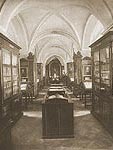About the Manuscript
History of the Manuscript
The Ostromir Gospel was created with a special purpose. It was intended for a precious donation to the St. Sophia Cathedral, the main church of Northwestern Russia, which was erected in 1045-1050 in Novgorod after the model of St. Sophia of Kiev (this temple was laid in 1037).
The oldest Russian manuscript has the exact date of its creation — 1057. So it has witnessed all of the Russian state evolution over time. However, the thousand-year history of the book is known only in general terms. The first page of the Ostromir Gospel contains the 17th century inscription, made in the cursive writing, "The Gospel of Sophia, a lectionary". This indicates that the manuscript belonged to some St. Sophia Church. Most likely, the Ostromir Gospel had been held in the Novgorod St. Sophia Cathedral for several centuries, until it was transferred to Moscow (no one knows when this happened). Documentary, the history of the manuscript can be traced only from the 18th century. The property inventory of the Resurrection Church in the Moscow Kremlin, compiled in 1701, provides evidence that the Ostromir Gospel was there at that time. In 1720, the ancient book was sent to St. Petersburg, where its tracks were lost again. In 1805, the Ostromir Gospel was discovered by the personal secretary of Catherine II Ya. Druzhinin, among the property of the deceased Empress who showed a great interest in Russian history during her lifetime.
In 1806, Emperor Alexander I gave the Ostromir Gospel to the Imperial Public Library (the former name of our Library). The Manuscripts Department of the Library was established only a year earlier - in 1805. Thus, the Ostromir Gospel laid the foundation of the richest manuscript collections of our Library.Since this moment, the research efforts have begun to explore the earliest Russian manuscript. All the history of the study of the Ostromir Gospel is directly connected with the National Library of Russia, the oldest state public repository of handwritten texts.

